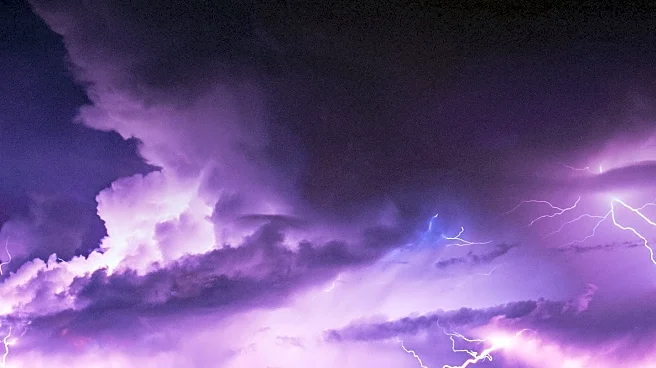What's Happening?
Recent research presented at the 2025 Annual Scientific Meeting of the American College of Allergy, Asthma and Immunology highlights a phenomenon known as 'thunderstorm asthma.' This condition involves a spike in breathing difficulties during or immediately
after thunderstorms, leading to increased emergency room visits. Emma Lin, MD, a pulmonologist and founder of ReadyO2, notes that outdoor runners may confuse these breathing issues with fatigue. The study analyzed asthma-related ER visits from January 2020 to December 2024 across three Kansas hospitals, revealing that 14% of cases occurred on days with thunderstorms, despite such days comprising only 2% of the total measured days. The research suggests that thunderstorms can exacerbate asthma symptoms due to pollen particles becoming smaller and more penetrable during storm conditions.
Why It's Important?
The findings underscore the need for individuals with asthma or pollen allergies to take precautions during thunderstorms. The study's lead author, Diala Merheb, MD, emphasizes the importance of incorporating storm-specific precautions into asthma action plans. This is particularly relevant for older adults and outdoor enthusiasts, such as runners, who may be at increased risk of severe respiratory issues during and after storms. The research highlights the broader implications for public health, as understanding and mitigating environmental triggers can reduce emergency room visits and improve quality of life for those affected by asthma and allergies.
What's Next?
Experts recommend that individuals with asthma or allergies monitor weather conditions and pollen counts before engaging in outdoor activities. Selina Gierer, DO, suggests treating thunderstorms like high-pollen days, advising the use of medications, hydration, and indoor exercise alternatives when necessary. This proactive approach can help manage asthma symptoms and prevent emergency situations. As awareness of thunderstorm asthma grows, healthcare providers may develop more comprehensive action plans to address this environmental trigger.
Beyond the Headlines
The phenomenon of thunderstorm asthma raises questions about the impact of climate and weather patterns on respiratory health. As climate change potentially alters weather patterns, understanding these effects becomes crucial for public health planning. The study also highlights the need for further research into environmental factors that exacerbate respiratory conditions, potentially leading to improved treatment and prevention strategies.















